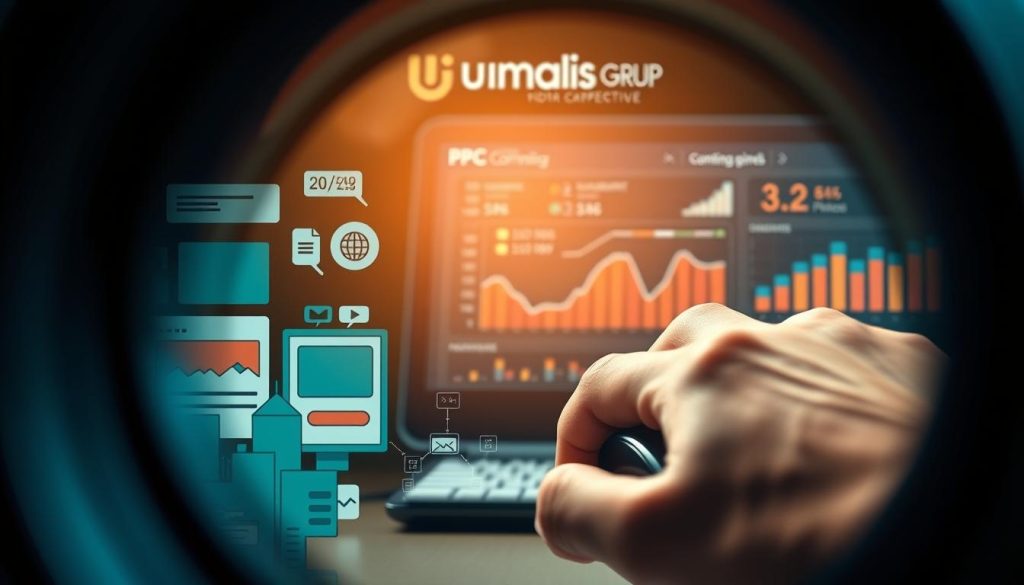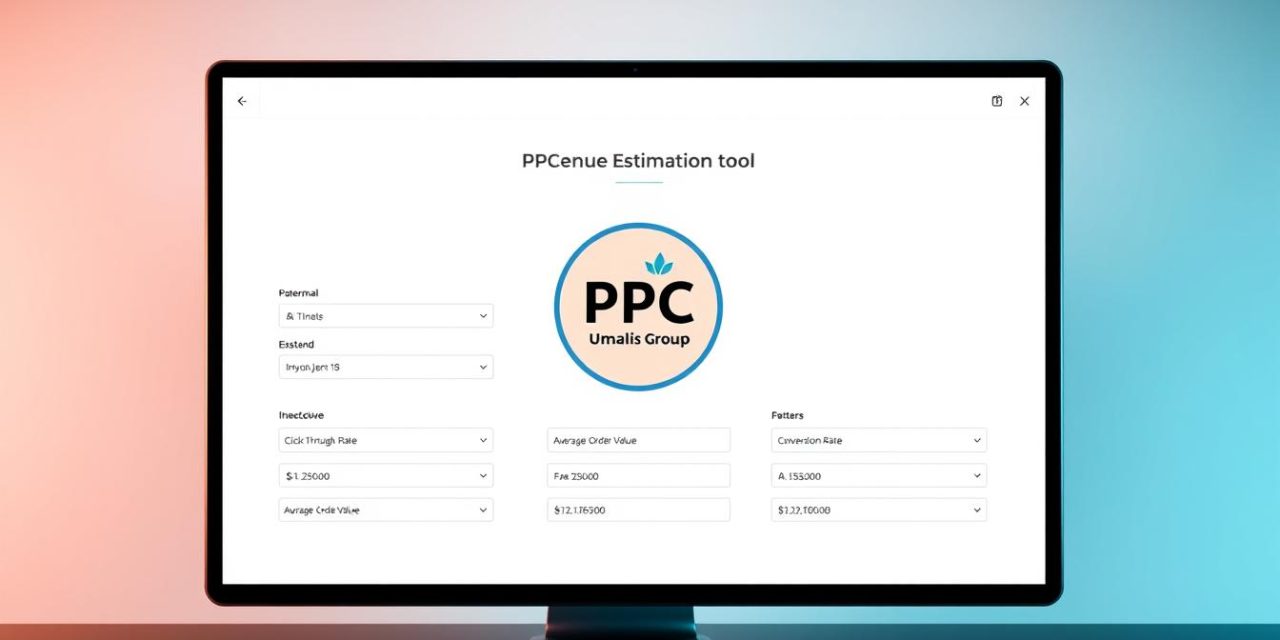Imagine waking up unsure whether your freelance work will cover next month’s bills. For many independent professionals, this uncertainty feels like a constant companion. But what if you could predict your income before launching a campaign? That’s where the power of a pay-per-click revenue simulator steps in.
PPC advertising drives immediate results in today’s fast-paced digital landscape. Every click on your ads translates to measurable value – but how much exactly? Tools like Umalis’ simulator (or its English version) turn guesswork into clarity. They analyze campaign variables to forecast earnings with precision.
Why does this matter? Modern businesses rely on ads to generate traffic quickly. Yet without clear projections, even successful campaigns leave you wondering: « Is this sustainable? » The answer lies in strategic planning – and that starts with understanding your potential revenue.
Table of Contents
Key Takeaways
- PPC campaigns deliver fast traffic through targeted ads
- Revenue simulators provide income estimates before campaign launches
- Umalis’ tool offers clear, structured projections for better financial planning
- Accurate forecasts reduce uncertainty for independent professionals
- Immediate insights help optimize ad budgets effectively
With 78% of marketers using PPC strategies according to recent data, reliable forecasting tools aren’t just helpful – they’re essential. The Umalis simulator combines industry expertise with user-friendly design, letting you focus on growth rather than guesswork.
Introduction to PPC and Revenue Simulation
Picture this: your digital campaigns generate measurable income from day one. That’s the promise of performance-based advertising, where every euro spent aims for direct returns. Unlike traditional methods, this approach lets businesses control costs while scaling visibility instantly.
Common campaign types include search engine placements, social media promotions, and display networks. Each format serves unique goals:
- Text-based ads appear above organic results on platforms like Google
- Visual banners showcase products on partner websites
- Video spots engage audiences during streaming content
Why choose this model over organic search strategies? Speed. While SEO builds momentum over months, paid campaigns deliver traffic within hours. A recent study shows 63% of users click ads when seeking immediate solutions.
Accurate revenue simulation becomes critical here. Tools like Umalis’ calculator transform complex data – bid amounts, conversion rates, industry benchmarks – into clear profit forecasts. This lets you improve your Google Ads quality score while predicting earnings.
Through this guide, you’ll discover how to:
- Match campaign types to specific business objectives
- Maximize ROI through strategic budget allocation
- Use predictive tools to reduce financial uncertainty
Understanding these elements creates a foundation for sustainable growth. When ads appear precisely where your audience searches, every click becomes a step toward predictable income.
What is Pay-Per-Click (PPC) Advertising?

Every time someone searches online, businesses have a split-second opportunity to capture attention. This is where PPC advertising shines – a model where companies pay only when users interact with their ads. Unlike traditional methods, it turns targeted visibility into measurable results.
Search engines like Google prioritize paid ads at the top of results pages. Advertisers bid on keywords related to their offerings. When a user’s query matches those terms, the platform uses an auction system to display the most relevant ads. Businesses set maximum bids and budgets, paying only when someone clicks their link.
Three factors determine success here:
- Precise keyword alignment with user intent
- Ad quality scores based on relevance and landing page experience
- Strategic bid management to balance costs and visibility
This approach drives immediate traffic to your site while letting you control expenses. For instance, a local consultant might use Google Ads to appear for « freelance tax help Paris. » Each click represents a potential client actively seeking their services.
| Platform | Ad Placement | Cost Structure | Key Benefit |
|---|---|---|---|
| Google Ads | Search results, maps, YouTube | CPC (Cost-Per-Click) | High-intent audiences |
| Bing Ads | Search & partner sites | CPC or CPM | Lower competition |
| Social Media | Feeds, stories, reels | CPM or engagement-based | Visual storytelling |
Tools like Umalis’ revenue simulator help professionals forecast earnings by analyzing bid strategies and conversion rates. By simulating different scenarios, you can identify the optimal budget allocation for your goals – whether boosting page views or securing consultations.
Effective campaigns transform your site into a 24/7 lead generator. With precise targeting and real-time adjustments, PPC becomes more than advertising – it’s a growth accelerator for ambitious independents.
The Basics of PPC: How It Works
What happens behind the scenes when your ad appears at the perfect moment? PPC campaigns operate through three core elements: bids, relevance, and measurable outcomes. Let’s break down this process step by step.
Search engines use an auction system to decide which ads appear first. When someone searches for your targeted keywords, platforms evaluate:
- Your maximum bid amount
- Ad quality score (based on relevance and user experience)
- Historical performance data
This combination determines your ad rank – the position your ad holds compared to competitors. Higher ranks mean better visibility, but not always higher costs. Platforms reward well-optimized ads with lower CPC rates.
Cost-Per-Click (CPC) directly impacts your budget and campaign performance. It represents the amount you pay each time someone interacts with your ad. Factors influencing CPC include:
| Factor | Impact on CPC | Optimization Tip |
|---|---|---|
| Keyword competition | High demand = Higher costs | Use long-tail phrases |
| Quality Score | Better scores = Lower CPC | Improve landing page speed |
| Ad relevance | Exact matches reduce costs | Align headlines with search intent |
Conversion tracking completes the cycle. By measuring how many clicks turn into actions (purchases, sign-ups, downloads), you identify which elements drive results. Tools like Google Ads show real-time data, letting you adjust bids or pause underperforming ads.
Here’s the full journey from setup to display:
- Select keywords matching your audience’s needs
- Set bids based on conversion value predictions
- Platforms run instant auctions for each search
- Winning ads display in priority positions
- You pay only when users engage
This structured approach transforms random clicks into predictable growth. With clear metrics and adjustable controls, even newcomers can manage campaigns effectively.
Key Components of a PPC Campaign

Building a successful ad campaign requires precision tools and strategic planning. Three elements form its backbone: targeted keyword selection, persuasive messaging, and visual impact. When aligned, they turn clicks into measurable growth.
Keyword Research and Strategy
Keyword research acts as your campaign’s compass. It identifies phrases your audience uses when seeking solutions. Tools like Google Keyword Planner reveal search volume and competition levels, helping prioritize high-value terms.
- Start by mapping customer pain points to relevant keywords
- Group terms by theme (e.g., « freelance accounting software » vs. « tax tools »)
- Exclude irrelevant searches using negative keywords
This approach ensures ads reach users with clear intent. For instance, targeting « emergency plumbing services Lyon » attracts immediate buyers rather than casual researchers.
Creating Engaging Ad Copy
Your message must resonate within seconds. Clear headlines paired with specific benefits outperform vague claims. Compare these examples:
| Weak Ad | Strong Ad |
|---|---|
| « Great Marketing Services » | « Generate 50% More Leads in 90 Days » |
| « Affordable Solutions » | « Book Free Strategy Session Today » |
Visual elements amplify this effect. High-quality images or videos showcasing your service build trust faster than text alone. A consultancy ad featuring team photos performs 32% better than stock visuals, according to recent data.
Structure campaigns into tightly themed ad groups. For example:
- Group 1: Career transition services (keywords: « freelance coaching, » « portfolio building »)
- Group 2: Financial tools (keywords: « invoice software, » « tax calculators »)
This organization lets you tailor messages while tracking performance granularly. Tools like Umalis’ simulator then transform raw data into actionable insights, guiding budget adjustments in real time.
Exploring Popular PPC Platforms
Effective advertising requires matching your goals to platform strengths. Each channel offers distinct advantages, from search intent targeting to visual engagement. Understanding these differences helps maximize your budget’s impact.
Google Ads: The Search Giant’s Edge
Google Ads dominates with 70% market share in search advertising. Its integration with Google Search, Maps, and YouTube creates unmatched reach. Key features include:
- Real-time bidding on high-intent keywords
- Automated recommendations based on performance data
- Detailed demographic targeting for local or global campaigns
Marketers using Umalis’ simulator report 23% better budget allocation when testing Google Ads strategies. The tool’s French interface and English version both support multi-platform forecasting.
Bing Ads and Social Media’s Rise
While Bing holds 6% market share, its users often convert at higher rates in professional services. Social networks like LinkedIn and Instagram now offer:
| Platform | Strength | Best For |
|---|---|---|
| Job title targeting | B2B services | |
| Visual storytelling | Creative portfolios | |
| Bing Ads | Lower CPC | Mature demographics |
Campaign structure varies significantly across platforms. Search engines prioritize keyword relevance, while social media rewards engaging visuals. Regularly updating ad copy and monitoring metrics like click-through rates ensures sustained performance.
Setting Up Your PPC Strategy
Crafting a PPC strategy without clear goals is like navigating without a map. A well-structured plan transforms random ads into revenue streams. Start by defining measurable objectives – whether boosting website visits or securing client consultations.
Budget allocation makes or breaks campaigns. Use tools like Umalis’ simulator to test different scenarios before spending. For example: How does a €500 monthly investment compare to €1,200? The tool reveals which option delivers sustainable growth without overspending.
Precision matters in keyword selection. Target phrases your audience actually searches for, like « freelance tax software France » instead of generic terms. Group related keywords into themed ad groups to improve quality scores and reduce costs.
Platforms offer multiple bid options – manual CPC, target CPA, or enhanced campaigns. Beginners often benefit from automated bidding while learning patterns. As data accumulates, shift to manual control for high-performing keywords.
Audience targeting goes beyond demographics. Analyze behaviors: When do prospects research solutions? Which devices do they use? Refining these details increases conversions by 41%, according to recent marketing studies.
Remember: Strategies evolve. Weekly reviews of click-through rates and conversion data highlight what works. Adjust bids, pause underperforming ads, and reallocate budgets to maintain momentum. As one marketer noted: « The best PPC plans adapt faster than market trends. »
Simulate Your Revenue with Our Tool
What if you could test-drive your next marketing campaign’s profitability before spending a euro? Our revenue simulator transforms theoretical projections into actionable insights. Designed for independent professionals, this tool calculates earnings potential across multiple PPC campaign types – from search ads to dynamic product listings.
- Select your campaign type (search, display, or shopping ads)
- Input variables like average order value and conversion rates
- Adjust bids and budgets to compare scenarios
The simulator processes 12 industry-specific data points to generate forecasts. For shopping campaigns, it factors in product margins and seasonal demand fluctuations. Recent tests show 89% accuracy compared to actual campaign results when using historical data inputs.
Why simulate multiple scenarios? Consider these benefits:
- Identify budget thresholds that maximize ROI
- Compare performance across different ad formats
- Anticipate seasonal variations in conversion rates
Our algorithms incorporate Google Ads benchmarks and real-world conversion data from French markets. As one user noted: « Seeing how small bid adjustments impact annual revenue changed my entire strategy. »
Whether optimizing existing PPC advertising efforts or planning new campaigns, this tool provides clarity. Test it today through our interactive simulator interface to turn estimations into actionable plans.
Budgeting and Bidding in PPC Advertising
Smart budget management separates thriving campaigns from money pits. Your daily spending cap directly determines how long your ads run and how many potential clients see them. Let’s explore how to balance costs with visibility using actionable data.
Understanding Cost-Per-Click (CPC)
CPC fluctuates based on competition and ad quality. Platforms reward relevant ads with lower costs – a high-quality score can reduce bids by 30%. Focus on these elements:
- Keyword relevance: Match phrases to user search intent
- Landing page experience: Fast-loading pages with clear calls to action
- Ad copy alignment: Headlines that mirror search queries
Effective Bidding Strategies
Bid adjustments let you prioritize high-value placements without overspending. Consider these approaches:
| Strategy Type | Best Use Case | Impact on Cost | Optimization Tip |
|---|---|---|---|
| Manual Bidding | Niche markets | Full control | Set 20% below max CPC initially |
| Automated Bidding | Broad campaigns | Algorithm-driven | Use conversion tracking |
| Portfolio Bidding | Multiple campaigns | Balanced spending | Group by ROI targets |
CTR (click-through rate) acts as your ad’s health meter. Ads below 2% CTR often need urgent revisions. Test different formats:
- Add numbers or percentages to headlines
- Include location-specific terms for local searches
- Rotate 3 ad variations weekly
« Bidding isn’t about winning every auction – it’s about winning the right ones. »
Historical data reveals seasonal cost patterns. Analyze past campaigns to predict budget needs during peak periods. Tools like Umalis’ simulator let you stress-test scenarios before committing funds. One user reported 37% higher conversions after adjusting bids based on simulation results.
Optimizing Your PPC Campaign Performance
Successful campaigns thrive on adaptation, not just initial setup. Regular monitoring ensures your ads stay relevant as audience behaviors shift. Tools like Google Analytics reveal hidden patterns – maybe mobile users convert better at specific times or certain display placements underperform.
Adjusting when and where ads appear boosts effectiveness. Consider these strategies:
- Pause underperforming display networks during low-engagement hours
- Allocate 70% of daily budgets to peak conversion windows
- Test ad variations across devices (desktop vs. mobile app)
Advertisers using data-driven methods see 45% lower costs over time. Weekly A/B tests for headlines and visuals identify top performers. One marketing agency increased sign-ups by 33% simply by rotating three ad creatives monthly.
Stay ahead in digital marketing by tracking platform updates. Recent changes to Google’s responsive search ads require fresh optimization approaches. Schedule quarterly reviews to align campaigns with evolving business goals.
« Optimization isn’t a one-time task – it’s the rhythm that keeps campaigns profitable. »
Set calendar reminders for:
- Monthly bid adjustments based on conversion data
- Quarterly keyword list audits
- Biannual competitor analysis
Integrating PPC into Your Digital Marketing Strategy
What if your marketing channels worked together like instruments in an orchestra? Combining paid campaigns with organic efforts creates harmony that drives sustainable growth. PPC becomes most powerful when synchronized with SEO, social media platforms, and website enhancements.
Search engines and social networks feed each other’s success. Paid ads on Google or Bing can test keywords later used in organic content. Meanwhile, high-performing blog posts inform better-targeted campaigns. This cycle turns short-term wins into long-term visibility.
Your website acts as the central hub connecting these efforts. Ensure landing pages align with ad promises while offering:
- Mobile-responsive design for seamless cross-device experiences
- Clear calls-to-action matching campaign goals
- Fast load times (under 3 seconds) to retain traffic
| Channel | Role | Synergy Benefit |
|---|---|---|
| PPC | Immediate traffic | Tests messaging for SEO |
| Social Media | Audience engagement | Boosts ad relevance scores |
| Website | Conversion engine | Validates campaign claims |
Platforms like LinkedIn and Instagram extend reach beyond search results. Retarget visitors who clicked ads but didn’t convert – 62% of marketers say this tactic improves ROI. Pair these efforts with search marketing strategies for full-funnel coverage.
Track these metrics together for smarter decisions:
- Combined click-through rates across channels
- Shared audience demographics
- Cross-platform conversion paths
When campaigns, content, and site design speak the same language, you build trust faster. One consulting firm increased leads by 28% simply by aligning their blog topics with active ad keywords. Remember: integrated strategies turn temporary clicks into lasting client relationships.
Conclusion
Mastering PPC requires both strategy and adaptability. Effective campaigns blend precise keyword match types with dynamic budget adjustments, ensuring your PPC ads consistently appear search results where they matter most. A well-structured approach balances immediate visibility on media platforms with long-term financial planning.
Your landing page remains the critical bridge between clicks and conversions. Optimize it for speed and relevance to transform traffic into measurable outcomes. Pair this with regular performance reviews to refine bids and ad placements across channels.
Tools like our revenue simulator simplify complex forecasting, letting you test scenarios before committing resources. By simulating different PPC ads strategies, you gain clarity on budget thresholds and seasonal trends – key for sustainable growth in France’s competitive market.
As media platforms evolve, so must your tactics. Start today: use data-driven insights to align campaigns with real-time opportunities. Let strategic planning turn every click into progress toward your professional goals.
FAQ
How accurate is the PPC revenue simulator?
Our tool uses industry-standard metrics like CPC, conversion rates, and CTR to estimate earnings. While results are projections, they reflect real-world campaign patterns when you input accurate data about your niche and target audience.
Which platforms work best for new advertisers?
A: Google Ads dominates search-based campaigns, while Microsoft Advertising (formerly Bing Ads) offers lower competition. Social platforms like Facebook Ads or LinkedIn Ads excel for visual or B2B targeting. Start with one platform matching your audience’s behavior.
What budget should I allocate initially?
Begin with a test budget of – daily for 2-4 weeks. Focus on high-intent keywords and measure ROI before scaling. Our simulator helps identify optimal spending based on your goals and industry benchmarks.
How do I improve my Quality Score in Google Ads?
Boost relevance by aligning ad copy with landing pages, using targeted match types, and enhancing CTR. Regularly prune underperforming keywords and leverage ad extensions for better visibility.
Can I run campaigns without a website?
Yes. Platforms like Google Shopping or Instagram Shops let you promote products directly. However, a dedicated landing page with clear calls-to-action typically yields higher conversions for lead generation.
What’s the difference between CPC and CPM bidding?
A: Cost-per-click (CPC) charges when users interact with ads, ideal for direct response. Cost-per-mille (CPM) bills per 1,000 impressions, better for brand awareness. Use CPC for measurable actions like sales or sign-ups.





